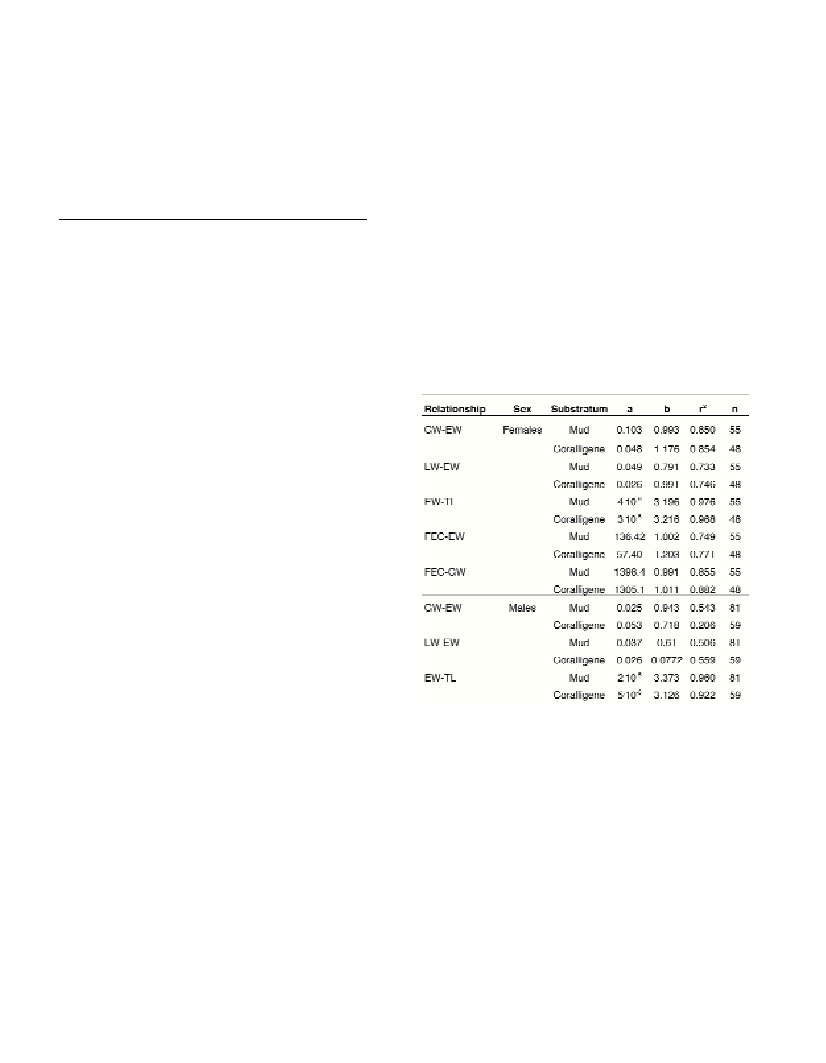CONDITION AND FECUNDITY OF RED MULLET OVER MUDDY AND “CORALLIGENE” SUBSTRATA
S. Somarakis
1,2*
, Ch. Stamataki
2
, A. Machias
2
, N. Papadopoulou
2
, C. Smith
2
, I. Karakassis
2
1
University of Patras, Department of Biology, Patra, Greece - * somarak@upatras.gr
2
Institute of Marine Biology of Crete, Iraklio, Crete, Greece
Abstract
We compared somatic, gonadal and hepatic condition as well as batch fecundity of red mullet (Mullus barbatus) between two sites
differing in substratum type. The first site had muddy substratum, whereas the second site was covered by dense patches of calcareous
algae and associated biogenic structures (“coralligene”). The results suggested that red mullet was in superior condition over coralligene,
where fish had significantly (P<0.05) higher hepatic or somatic mass. Batch fecundity did not differ (P>0.05) between sites.
Keywords: Mullus barbatus, condition, fecundity, coralligene
Rapp. Comm. int. Mer Médit., 37,2004
443
Introduction
The red mullet, Mullus barbatus, is one of the most important
species for the Mediterranean fisheries. It is abundant throughout the
continental shelf, over both muddy and coarser substrata, although it
shows maximum abundance and frequency of occurrence over muddy
bottoms (1).
In the present contribution we present preliminary results of the
comparison of somatic condition, organ condition and fecundity of
red mullet between muddy and coralline algae substrata. The latter
comprise important fishing sites for local small-scale fisheries (2).
Materials and methods
Three replicate hauls were taken at each of two sites of similar
depth (70-90 m) in the South Evoikos Gulf (Aegean Sea) using an
otter trawl with a cod-end bag liner of 28 mm stretched mesh-size.
The first site had muddy substratum (90% silt and clay) whereas the
other one was considerably coarser (89% sand and gravel) and
dominated by dense patches of biogenic structures related to colony-
forming calcareous algae of the class Rhodophycae (“coralligene” [3],
“tragana” in Greek). The substratum types were determined by grain
size analysis and side scan sonar tows over the trawl path.
A sample of red mullets was randomly selected from each haul and
fixed in 10% buffered formalin solution. In the laboratory, the fish
were measured (total length [TL], 1mm; total weight [TW], 0.01g;
eviscerated weight [EW], 0.01g), sexed and their gonads and liver
dissected and weighted (gonad weight [GW], 0.0001g, hepatic weight
[LW], 0.0001g). Samples from the gonads were subsequently
dehydrated and embedded in paraffin. Sections (4-6
µ
m) were cut and
stained with hematoxylin and eosin. The hydrated oocyte method was
used for batch fecundity measurements (4).
For each site, we modeled GW, LW and batch fecundity (FEC) on
EW as well as EW on TL and FEC on GW using the allometric
equation: Y=aX
b
exp(
e
). In all cases, this simple model was more
efficient in terms of residuals and explanation of the variation than
other models. Analysis of covariance (ANCOVA) was used to test for
between-site differences in the log-log relationships between
variables. Slopes were tested first using a model that included an
interaction term. If the interaction term was not significant (i.e. slopes
were not significantly different between sites), then the y-intercepts
were tested.
Results and conclusion
Histological analysis of the gonads revealed that 99 and 100% of
the analysed females and males were in the hydrated and
spermatogenic stage, respectively. Non-hydrated females were not
used in the subsequent analyses.
The calculated parameters of the allometric relationships for each
site and sex are given in Table 1. The ANCOVA results indicated that,
for both sexes, the LW-on-GW relationship had higher intercept in the
coralligene site (females: P<0.05, males: P<0.0001). The EW-on-TL
relationship for females had also higher intercept in the coralligene
site (P<0.001). No significant (P>0.05) differences between sites were
found for the fecundity relationships (FEC-on-EW and FEC-on-GW).
These preliminary results suggest that red mullet was in superior
condition in the coralligene site, where the fish had, on average,
higher hepatic or somatic mass. This superior condition did not seem
to affect batch fecundity of mature females. The biological and
functional complexity of submarine coralligene (2) is likely to provide
superior feeding conditions for red mullets and other fishes.
Unpublished results from a diet analysis study seem to corroborate
this hypothesis; higher stomach contents weight was observed in the
diet of M. barbatusover coralligene sites with the main prey taxa
being decapods and small crustaceans which are thought to be of
higher nutritional value and energy content [5].
References
1-Lombarte A., Recasens L., Gonzalez M., and de Sola L.G., 2000.
Spatial segregation of two species of Mullidae in relation to habitat. Mar.
Ecol. Progr. Ser., 206: 239-249.
2-Georgiadis M., Papatheodorou G., Katselis G., Tzanatos E., Ramfos
A., Vavoulis D., and Koutsikopoulos C., 2001. Morphological
characteristics and distribution of “coralligene” fishing grounds
(Rhodophyceae) in the area of Cyclades. Proceedings of the 10
th
Panhellenic Conference of Ichthyologists, pp. 333-336.
3-Bonsence D.W.J., 1985. The “Coralligene” of the Mediterranean – a
recent analogue for the Tertiary coralline algal limestones. Pp. 216-225.
In: Toomey D.E., and Nitecki M.H. (eds), Paleoalgology: Contemporary
research and applications.
4-Maraveya E., Somarakis S., and Machias A., 2001. Batch fecundity of
anchovy in the NE Aegean Sea. Rapp. Comm. int. Mer Médit., 36: 299.
5-Norrbin F., Bamstedt U., 1984. Energy contents in benthic and
planktonic invertebrates of Kosterfjorden, Sweden. A comparison of
energetic strategies in marine organism groups. Ophelia,23: 47-64.
Table 1. Parameters of the allometric functions (Y=aX
b
) between gonad
weight (GW) and eviscerated weight (EW), liver weight (LW) and eviscer-
ated weight, eviscerated weight and total length (TL), batch fecundity
(FEC) and eviscerated weight, and batch fecundity and gonad weight.
n:sample size, r
2
: coefficient of determination, a,b: parameters of the
allometric model.

